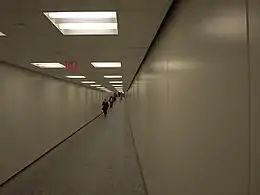Houston tunnel system
The Houston tunnel system is a network of subterranean, climate-controlled, pedestrian walkways that links 95 full city blocks 20 feet (6 m) below Houston's downtown streets. It is approximately 6 miles (9.7 km) long.[1] There are similar systems in Chicago, Dallas, Oklahoma City, Montreal and Toronto. Architectural historian Stephen Fox has stated that the idea for the tunnel system came when the Bank of the Southwest Building was "linked by tunnel to the 1010 Garage and the Mellie Esperson Building" in 1961.[2]

Description
The Tunnel is a series of underground passageways that, with above-ground skywalks, link office towers to hotels, banks, corporate and government offices, restaurants, retail stores, and the Houston Theater District. Portions of the tunnel contain gift shops, newsstands, banks, technology centers, flower shops, copy centers, dry cleaners, and food courts similar to a major shopping mall. They are widely and heavily used by office workers and tourists. Only two buildings, Wells Fargo Plaza and McKinney Garage on Main,[3] offer direct access from the street to the Tunnel; other entry points are from street-level stairs, escalators, and elevators inside buildings that are connected to the tunnel. Access is allowed to the general public into these buildings with few restrictions, during normal operating hours, in order to reach the Tunnel.
Most of the retail areas of the Tunnel are in the basements of these buildings, connected by passageways. While walking through, one can determine which building they are in by the unique signage and/or architectural design of that building, as well as the wayfinding system and Houston Tunnel maps (an example of which is shown to the right). Most of the Tunnel is in the western half of downtown Houston.[4] The tunnel is generally open during weekday business hours only.
The Tunnel has been criticized for its numerous stairways, especially in the northern portion, which make wheelchair use traffic impassable in some locations. Bob Eury director of the Houston Downtown District, stated that, "These areas haven't been made ADA-compliant because it would be difficult or impossible to put in ramps and still leave enough headroom for pedestrians."[5]
Discontinuous portions

The Harris County tunnel at the far north side of downtown is not connected to the rest of the system by either tunnels or skywalks. It connects Harris County courts, jails, and associated buildings totaling 10 blocks. Six blocks of the St. Joseph Medical Center are connected via skywalks at the southeast corner of downtown near the Pierce elevated.
The Houston Chronicle complex, at 801 North Texas, was connected to the Tunnel until those buildings were imploded in 2017; the newspaper's operations relocated to the former Houston Post complex (off the Southwest Freeway) in 2014.
Other parts not connected to the main Tunnel are the skywalk connections between the Hilton-Americas Hotel and George R. Brown Convention Center, the skywalk connections at the Toyota Center, and at the Houston Public Library.
Buildings connected
This is a partial listing.
- 1001 McKinney
- 1600 Smith
- 1400 Smith
- 1100 Louisiana
- 1111 Travis
- 1500 Louisiana
- Esperson - 808 Travis/815 Walker
- Commerce Towers
- Calpine Center
- JPMorgan Chase Tower
- Bank of America Center
- Pennzoil Place
- One Shell Plaza
- The Esperson buildings
- Wells Fargo Bank Plaza
- Centerpoint Energy Plaza
- Kinder Morgan Building
- Total Plaza
- One Houston Center
- First City Tower
- One Allen Center
- Wedge International Tower
- BG Group Place
- Texas Medical Center
- 1111 Fannin
Flooding
The tunnels, being underground, are prone to flooding. They serve as channels for floodwater, allowing it to move through the tunnels from flooded buildings to unflooded buildings, flooding buildings that would not have been flooded otherwise. This happened during Tropical Storm Allison, with the medical center alone sustaining over a billion dollars' worth of damages. After Allison, some of the buildings installed floodgates to prevent another occurrence of tunnel flooding.[6]
References
- "Downtown Houston". Retrieved 20 June 2016.
- David Kaplan (November 1, 2009). "Downtown tunnel system still drawing entrepreneurs". Houston Chronicle. Retrieved December 19, 2011.
- "Downtown Tunnels". www.downtownhouston.org. Retrieved 2017-12-19.
- "Archived copy". Archived from the original on 2008-12-31. Retrieved 2008-12-08.CS1 maint: archived copy as title (link)
- Bill Murphy (August 18, 2008). "Downtown Houston tunnels unkind to wheelchair users". Houston Chronicle. Retrieved December 19, 2011.
- "Natural Catastrophes" (PDF). http://www.rms.com/publications/natural-catastrophes. p. 11. Retrieved 11 September 2018.
Total damage in the Houston region is estimated at $5 billion. The Texas Medical Center (TMC) and downtown Houston had particularly heavy losses. In the TMC, surface water entered underground parking garages and tunnels, flooding critical infrastructure within basement areas. Damage estimates for the TMC exceed $2 billion, of which $600 million in insurance claims are expected. In downtown Houston, the pedestrian tunnel system was inundated with floodwaters seeping in from the overflowing Buffalo Bayou. As a result, many downtown businesses operating in the tunnels or relying on the tunnel network for access to infrastructure and parking experienced interruptions for several months.
…
Floodwaters entered several subterranean parking garages, tunnels, air vents, loading docks, and utility chases within the TMC. Floodwaters were then conveyed across the TMC complex by connecting tunnel passages, and basements began to flood even in areas where there was little surface flooding. Subterranean flooding was particularly heavy in facilities connected to a major tunnel that runs parallel to Fannin Street.
…
TS Allison painfully illustrated the vulnerability of buildings to subterranean flooding, even when no surface level flooding has occurred. While FEMA Flood Insurance Rate Maps (FIRMs) are essential risk analysis tools for insurers, they do not assess all the possible modes of water entry into a given building. Therefore, a FIRM assessment should be supplemented with a thorough evaluation of potential entry points for floodwaters, such as underground parking and tunnel connections, return air louvers, loading docks, utility chases, and below-grade windows and doors.
External links
| Wikimedia Commons has media related to Houston tunnel system. |